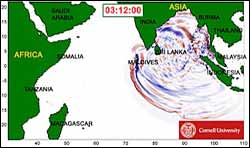Graphic video simulation of Indian Ocean tsunami

Copyright © Cornell University
Cornell University researchers have created a video simulation of the deadly Dec. 26 Indian Ocean tsunami that shows in graphic detail how the massive wave system spread outward from the epicenter of an undersea earthquake northwest of Sumatra, Indonesia.
The simulation makes it clear how the tsunami struck the coastlines of Indonesia, Thailand, Sri Lanka and India with such devastating force, then continued as far as East Africa.
The video, about 7 MB, can be seen online at http://www.news.cornell.edu/releases/Jan05/tsunamiVid320.html .
A 640×480 Quicktime version, about 43 MB, is available at http://www.news.cornell.edu/releases/Jan05/tsunamiVid640.html . (This will take several minutes to load even on a fast Internet connection.)
The video compresses 10 hours and 30 minutes in the life of the tidal wave into one minute, showing in contrasting colors the advancing high water and the trough behind it, as well as the receding waters observed along coastlines near the epicenter before the wave struck. It shows high water in red and low in blue. The more intense the color, the greater the displacement from sea level. A clock in the animation starts at the moment of the Sumatra earthquake.
The computer simulation was created using a numerical model called the Cornell Multigrid Coupled Tsunami model, or COMCOT, developed by Philip Liu, Cornell professor of civil and environmental engineering, and graduate student Xiaoming Wang. The model was originally created by Japanese scientists, further developed by Liu and several of his students, and most recently refined and updated by Wang. Wang created the final video with Tso-Ren Wu, a Cornell post-doctoral researcher.
Liu, who helped develop the Pacific Ocean tsunami warning system, is currently leading a delegation of scientists studying the effects of the tsunami in Sri Lanka, and will report findings at a symposium there Jan. 15. The computer model assumes that the up-and-down motion of the sea floor caused by the earthquake occurred in just a few seconds, so the sea water above was deformed in the same way as the earth below, since there was no time for the water to get out of the way. Tsunamis are created when water is lifted by energy generated by earthquakes and then falls back.
Based on earthquake data and information about the topography of the sea floor provided by the U.S. National Oceanic and Atmospheric Administration (NOAA), the COMCOT model calculates the elevation of the sea surface at a series of grid points on a map of the area over a period of time. The video is generated from this information. How closely the simulation corresponds to what actually happened will not be determined until data is collected in the field, Wang said.
Accurate seismic data generally is available only after an event is over. With the future development of seismic technology, a more accurate and rapid estimation of seismic data might be provided, he said. It then might be possible to use such simulations to predict tsunami behavior immediately after an earthquake is detected.
Media Contact
All latest news from the category: Earth Sciences
Earth Sciences (also referred to as Geosciences), which deals with basic issues surrounding our planet, plays a vital role in the area of energy and raw materials supply.
Earth Sciences comprises subjects such as geology, geography, geological informatics, paleontology, mineralogy, petrography, crystallography, geophysics, geodesy, glaciology, cartography, photogrammetry, meteorology and seismology, early-warning systems, earthquake research and polar research.
Newest articles

Skyrmions move at record speeds
… a step towards the computing of the future. An international research team led by scientists from the CNRS1 has discovered that the magnetic nanobubbles2 known as skyrmions can be…

A flexible and efficient DC power converter for sustainable-energy microgrids
A new DC-DC power converter is superior to previous designs and paves the way for more efficient, reliable and sustainable energy storage and conversion solutions. The Kobe University development can…

Technical Trials for Easing the (Cosmological) Tension
A new study sorts through models attempting to solve one of the major challenges of contemporary cosmic science, the measurement of its expansion. Thanks to the dizzying growth of cosmic…




















